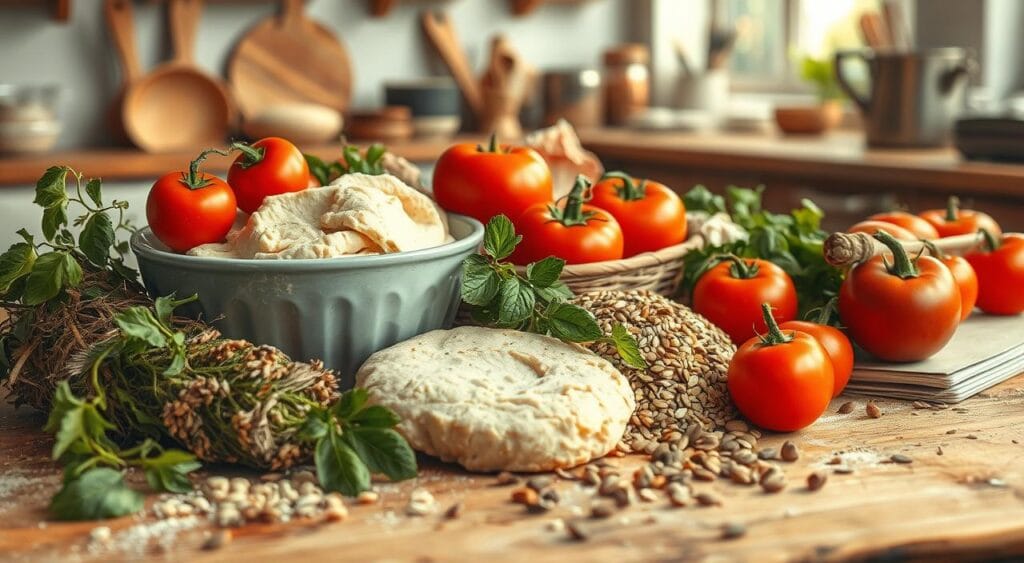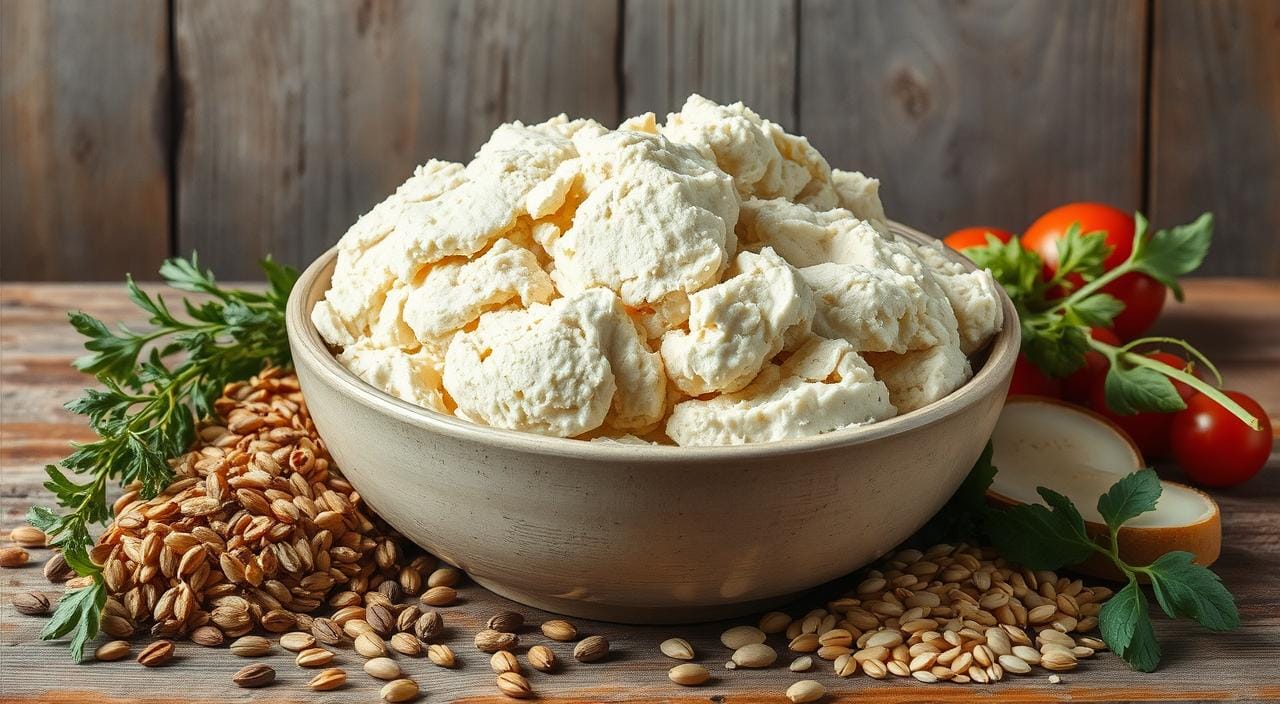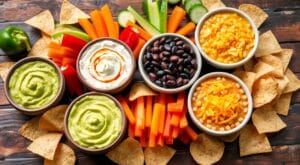Jump to:
Estimated reading time: 13 minutes
Table of contents
The art of sourdough baking has seen a big comeback. This has brought a lot of interest in the sourdough discard health benefits. People now see sourdough discard as a way to reduce waste and add flavor to meals. But is it just a passing trend, or does it really have value in our diets?
Sourdough discard is a key part of making sourdough bread. It’s the part set aside before feeding the starter again. It’s full of probiotics, which are good for our gut health. It also has a lot of fiber, which helps control blood sugar and keeps us feeling full.
Plus, it has important vitamins and minerals like B vitamins, iron, and zinc. So, instead of throwing it away, we can use it to make our food healthier and tastier.
Is eating sourdough discard healthy? Key Takeaways
- Sourdough discard is more than a baking by-product; it is burgeoning with probiotics that fortify the gut microbiome.
- Its inclusion in recipes underscores the sourdough discard nutrition factor, upgrading the healthfulness of your baked goods.
- Fiber-rich sourdough discard can play a role in managing blood sugar levels, promoting both fullness and well-being.
- The nutritional value of sourdough discard extends to essential nutrients that are paramount to our daily dietary needs.
- Understanding the uses of sourdough discard not only curtails food waste but potentially elevates our health one loaf at a time.
Understanding Sourdough Discard and Its Place in Baking
The process of sourdough discard is fascinating. It makes bakery goods taste better and adds to their nutrition. People often see it as waste, but it’s key for keeping the sourdough starter healthy.
The Process of Creating and Maintaining a Healthy Sourdough Starter
Creating a sourdough starter is both an art and a science. You feed it fresh flour and water regularly. This keeps the bacteria and yeast alive and healthy.
You also have to remove some of the culture, known as ‘discard’. This keeps the starter active and ready to make bread rise and give it that tangy taste. It also makes the sourdough discard nutrition better by adding new nutrients and enzymes.
Why Discarding is Crucial for an Active and Healthy Sourdough Culture
Discarding is vital for the starter’s health and size. It helps control the acidity, which is good for fermentation. This process also spreads beneficial bacteria and yeasts, important for the health benefits of sourdough discard.

Don’t think of sourdough discard as waste. Creative bakers use it in many tasty treats, like pancakes, waffles, crackers, and cakes. It turns waste into food that’s both delicious and nutritious.
Utilizing Sourdough Discard in the Kitchen: Beyond Waste
Exploring sourdough discard clearly shows its value beyond just being waste. In fact, home bakers find creative ways to use it, not only enhancing flavors but also benefiting from the health advantages sourdough discard offers. Moreover, it can change how you cook, offering nutritious options that ultimately improve traditional recipes.
Many ask is sourdough discard good for everyday cooking. The answer is yes, thanks to its many uses and great taste. This part of sourdough is not only healthy but also adds depth to dishes.
Delicious and Creative Ways to Incorporate Discard into Everyday Recipes
- Use sourdough discard instead of buttermilk in pancakes and waffles for a tangy, fluffy taste.
- Add it to homemade bread recipes for a better rise and richer flavor.
- Make crispy crackers by mixing discard with flour, olive oil, and your favorite seasonings.
- Thicken and flavor spreads and dips with the discard for a unique taste.
The Flavor-Enhancing Properties of Sourdough Discard in Baking
Looking at is sourdough discard good for baking, it’s clear it does more than add nutrition. It brings out rich flavors that truly make baked goods special. Additionally, the discard adds a tangy taste, similar to artisanal bakery items, making it perfect for those who want better taste and texture in their baking.
Find more unique ideas and recipes for using sourdough discard. Make every meal special without wasting any part of your starter.
| Ingredient | Without Sourdough Discard | With Sourdough Discard |
|---|---|---|
| Pancakes | Typically made with milk or buttermilk | Richer flavor with a hint of tanginess |
| Bread | Standard rise and texture | Enhanced rise with improved flavor profile |
| Crackers | Usually basic taste | Added flavor complexity and crispiness |
| Spreads | Normal consistency and taste | Thicker and more flavorful |
Sourdough Discard Health Benefits: What’s Inside?
Looking into the health benefits of sourdough discard shows it’s a great choice for a healthy diet. This part of sourdough is often ignored but is full of good stuff for your health.
Is eating sourdough discard healthy? Probiotics and Gut Health: Sourdough Discard’s Role
Sourdough discard is full of probiotics, which are key for a healthy gut. In particular, they help with digestion and boost the immune system. As a result, this makes sourdough discard’s health benefits a top choice for gut health.
Fiber Content and Blood Sugar Regulation
Eating sourdough discard also means getting a lot of fiber. Fiber is great for keeping blood sugar levels in check. It also lowers cholesterol and helps you feel full, which is good for weight control.
Vital Vitamins and Minerals in Sourdough Discard
Sourdough discard is good for more than just your gut and metabolism. It’s also packed with important vitamins and minerals. You get B vitamins, iron, and zinc, which are key for energy and cell health.
| Nutrient | Benefit |
|---|---|
| Probiotics | Enhances gut flora, improves digestion and immune system |
| Fiber | Helps control blood sugar, reduces cholesterol, increases satiety |
| Vitamins B | Crucial for energy production and brain function |
| Iron | Supports oxygen transport and energy utilization |
| Zinc | Strengthens immune response and supports wound healing |
Is Sourdough Discard Good for Gut Health?
Looking into sourdough discard reveals that it’s great for gut health. Specifically, it’s full of probiotics from its fermentation. Consequently, this makes it beneficial for your digestive health.
Comparing Sourdough Discard’s Probiotic Content to Other Foods
Sourdough discard is a top choice for probiotics. It has natural lactobacilli, unlike some supplements or foods. These bacteria come from the sourdough’s natural fermentation. So, sourdough discard probiotics are great for a healthy gut.
The Impact of Sourdough Discard on Digestive Wellness
Adding sourdough discard to your diet can significantly boost your digestive health. Because its probiotics help keep your gut flora healthy, this is essential for digestion, absorbing nutrients, and supporting your immune system. So, sourdough discard good for gut health is an important part of staying well.
Using sourdough discard also adds flavor and health benefits. Learn more about keeping your sourdough starter.
| Food Item | Probiotic Content | Benefit to Gut Health |
|---|---|---|
| Sourdough Discard | High in Lactobacilli | Enhances gut flora, aids digestion |
| Commercial Yogurt | Often contains added probiotics | Supports gut health, but may have added sugars |
| Kefir | Rich in various probiotics | Improves digestion, boosts immunity |
Does Sourdough Discard Offer Nutritional Value?
Is eating sourdough discard healthy? Exploring the nutritional value of sourdough discard reveals that it’s packed with health benefits. Primarily, these benefits come from the fermentation process used to make it. Sourdough discard is often ignored but is full of nutrients that can boost a healthy diet.
Sourdough discard nutrition is a deliberate part of baking with sourdough. Understanding its benefits can lead to healthier and more sustainable baking habits.
Evaluating the Nutritional Profile of Sourdough Discard
Sourdough discard is just as nutritious as the starter it comes from. Notably, it’s full of vitamins, minerals, and probiotics that are beneficial for your gut. Specifically, it contains B vitamins, iron, potassium, and magnesium, making it an excellent addition to a varied diet. Moreover, the fermentation process makes these nutrients easier for your body to absorb and utilize.
How Fermented Foods Like Sourdough Discard Contribute to Nutrition
Fermentation, which makes sourdough discard, keeps and breaks down nutrients into easier-to-digest forms. Like other fermented foods, it helps your gut health, aids digestion, and boosts your immune system.
| Nutrient | Content in Sourdough Discard | Benefits |
|---|---|---|
| Probiotics | Varies | Improves gut health and digestion |
| B Vitamins | High | Energy production, brain function |
| Minerals (Iron, Magnesium) | Moderate | Oxygen transport, muscle function |
Adding sourdough discard to your meals not only cuts down on food waste but also takes advantage of its nutritional value. Whether used in traditional baking or new recipes, it becomes a great way to enhance your diet.
Is Sourdough Discard Better Than Commercial Baking Ingredients?
When we look at baking, we might ask, how does sourdough discard compare to commercial baking ingredients in health benefits? We see tradition and innovation meet in healthier baking options for home bakers.
Analyzing the Health Impacts of Sourdough Discard Versus Conventional Products
Sourdough discard often wins in a health comparison. Its natural fermentation boosts flavor and health benefits. Unlike commercial products full of preservatives, sourdough has natural yeasts and bacteria. These help the gut and lower the glycemic index.
Also, sourdough products make you feel fuller longer, aiding in weight and blood sugar control. For more on the health benefits of sourdough discard, check out this link.
Nutritional Advantages of Sourdough Discard in Home Baking
Using sourdough discard in home baking significantly boosts nutrition. Through its fermentation process, it breaks down phytates, making the minerals in flour easier to absorb. As a result, this leads to better absorption of iron, zinc, and magnesium in whole grain breads.
| Nutrient | Commercial Baking Ingredients | Sourdough Discard |
|---|---|---|
| Fibers | Low | Higher |
| Natural Yeasts | Absent | Present |
| Preservatives | High | Low |
| Glycemic Index | Higher | Lower |
Choosing sourdough discard over commercial options improves flavor and health. Home baking with sourdough discard offers nutritional advantages. It leads to a healthier lifestyle with tasty, nutritious treats.
“Is Eating Sourdough Discard Healthy?”: Separating Fact from Fiction
Is eating sourdough discard healthy? When we talk about sourdough discard health benefits, myths often come up. But, figuring out is eating sourdough discard healthy means understanding its nutrition and how it stacks up against fully fermented sourdough. Sourdough discard is often ignored but it has big benefits when used right in a balanced diet.
Sourdough discard comes from feeding and maintaining a sourdough starter. It’s particularly known for being easy to digest and supporting gut health. For individuals who are gluten-sensitive, sourdough discard can be a better option, as it retains some of the fermentative properties that help break down gluten.
- Ease of digestion
- Contributes to gut health
- Potentially suitable for gluten-sensitive individuals
Understanding the scope of sourdough discard health benefits and incorporating it wisely into meals can elevate its value in your diet.
Looking closer at its nutrition, sourdough discard isn’t as rich as fully matured sourdough. But, it still adds value to recipes with its subtle flavors and nutrients.
| Nutrient | Content in Sourdough Discard | Content in Fully Fermented Sourdough |
|---|---|---|
| Probiotics | Moderate | High |
| Fiber | Low | Medium |
| Vitamins & Minerals | Varies | Increased variety |
This table shows that sourdough discard health benefits aren’t as high as fully fermented sourdough. But, it still has a lot of nutritional value. So, the answer to is eating sourdough discard healthy depends on how you use it in your diet. Use it moderately and thoughtfully.
Customizing Sourdough Discard Usage for Enhanced Health Benefits
Turning simple baking into a health ritual requires thinking differently about sourdough discard. By understanding how to use both long-fermented sourdough discard recipes and quick methods, you can significantly change the health benefits of your baking.
Long Fermented vs. Quick Discard Recipes: Nutritional Implications
Long fermented sourdough recipes show a baker’s patience and offer more health benefits. They break down gluten well, helping those with mild gluten issues. They also boost probiotics, which are good for your gut.
Quick recipes are fast and easy but have fewer health perks. Yet, they still help reduce waste and add special flavors and textures to food.
Adjusting Recipes to Maximize the Health Benefits of Sourdough Discard
To make the most of enhancing health benefits of sourdough discard, know when and how to use it. You can adjust both long-fermented and quick recipes to fit your diet and health goals. Here’s a guide to their health benefits:
| Recipe Type | Health Benefit | Suitability |
|---|---|---|
| Long Fermented | Enhanced probiotics, reduced gluten content | Gluten sensitivity, digestive health |
| Quick Discard | Minimal waste, added flavors | Quick meals, flavor enhancement |
Both types of sourdough discard recipes add significant value to our cooking. They transform what would be waste into a key component of our diet. By opting for these recipes, bakers can create delicious meals while also improving their health.
Frequently Asked Questions
Is sourdough discard healthy to eat?
Yes, sourdough discard can be healthy to eat. It contains beneficial bacteria and yeast, as well as nutrients from the flour, such as fiber, protein, vitamins, and minerals. The fermentation process also breaks down phytic acid, which can help improve the absorption of certain nutrients, making sourdough discard a nutritious addition to recipes.
Are there probiotics in sourdough discard?
Yes, sourdough discard contains probiotics (live beneficial bacteria) when it is fresh. These probiotics are present as long as the discard is not cooked, as high heat destroys live bacteria. If you use sourdough discard in uncooked or lightly fermented recipes, you may benefit from these probiotics, which are good for gut health. However, when sourdough discard is used in baked recipes (like pancakes or bread), the heat from cooking kills the probiotics.
Can sourdough discard be used in a low-gluten diet?
Yes, sourdough discard can be beneficial in reducing gluten levels in recipes. The fermentation process in sourdough helps break down gluten, which can make it easier to digest for people with mild gluten sensitivities. However, it is not gluten-free and may not be suitable for those with celiac disease or severe gluten intolerance.
Does sourdough discard help with digestion?
Yes, the fermentation process in sourdough discard creates beneficial enzymes and bacteria that help break down complex carbohydrates, which can support digestion.
Are there any risks to eating sourdough discard?
Sourdough discard is generally safe to eat as long as it is fresh and has been stored properly. However, discard that smells off, shows signs of mold, or has been stored for longer than 1-2 weeks should be thrown away.
Conclusion
The journey into sourdough discard has shown its many sides, from baking to its sourdough discard benefits. Using sourdough discard in recipes helps reduce food waste. It also adds probiotics, fiber, and nutrients to our diet.
This fermented sourdough is good for gut health and better than commercial baking products. It’s great for making fluffy pancakes or crispy crackers. Sourdough discard is a versatile and healthy choice for cooking.
For those wanting to try healthy sourdough discard recipes, the internet has many options. A good place to start is at available recipes. These recipes show how to turn sourdough discard into tasty dishes with a unique tang.
From English muffins to quick breads, these recipes highlight sourdough discard’s versatility in baking.
In conclusion, sourdough discard is much more than a byproduct. It’s packed with flavor and nutrition, making it versatile for various cooking uses. However, moderation is key in all dietary choices. By incorporating sourdough discard, baking enthusiasts and health-conscious foodies can create meals that are both good for the planet and beneficial to our health.






